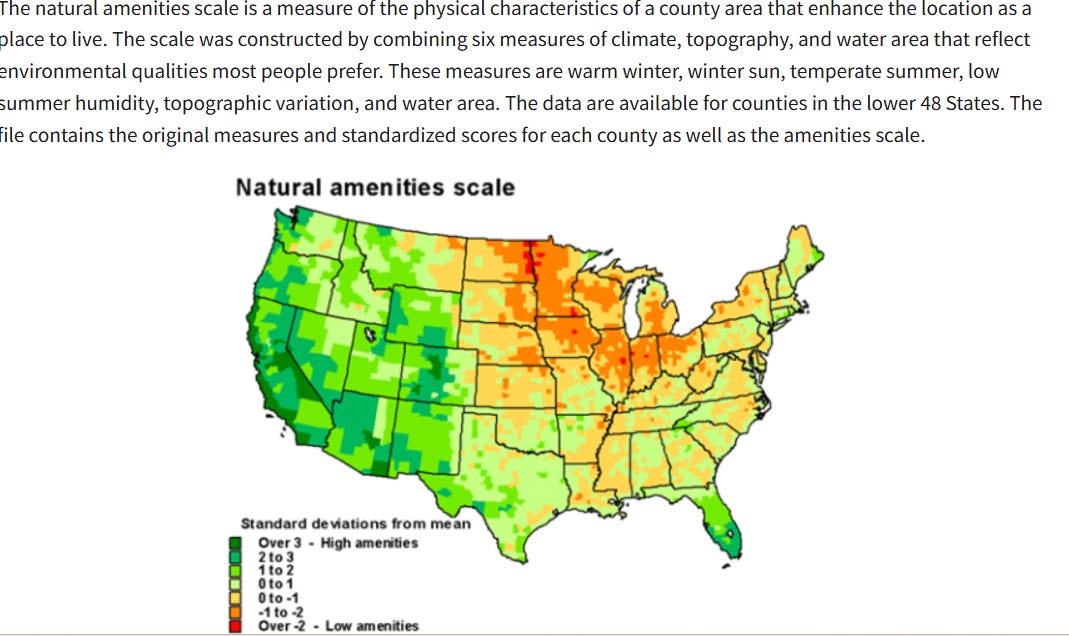Amenable amenities
Is moving worth it?
Not too long ago when I first started this weekly endeavor, I promised to bring you exciting offerings from USDA’s Economic Research Service. To satisfy the encouraging clamor from almost no one, I bring you this small offering.
My favorite subset of ERS data is its Natural Amenities Scale. Yes, researchers have mapped the country, figuring out which combination of hill, dale, sky and sea people find most pleasing. Once that determination has been made, the question becomes whether or not people go out of their way to actually inhabit those pleasing locations. In other words, do people consciously prefer certain landscapes, and make it a point to live there? If so, do they chose that place with a great view, even if it means a longer commute to work, or minimal access to services? Or do they swallow the pill of flat lands and gray skies, if it makes the work of life easier, or if they have friends and family nearby?
I wrote about this a bit in my book about the small town Midwest. But the research and publication of that book was more than 10 years ago. Since then, the U.S. Census Bureau has added data to the way I’ve thought about these sorts of things. The concept of chosing where to live is something I know well. I’ve done it deliberately, moving because of the emotional appeal based on beauty, or novelty, of a place. But the Census Bureau has helped me see that living life as performance art isn’t for most people.
In the article Why People Move, the Census Bureau notes that in 2021-2022, most people who moved did so for housing reasons. Like, wanting a nicer place, or someplace more convenient for their family size. Or, they were ready to buy, rather than rent. Sometimes they moved because of changes in family circumstance, or because a new location would be more convenient for work or school.
The majority people who moved stayed within their same county, though that choice has declined in recent years.
The statistics take in factors related to the Covid-19 pandemic, but nothing for the last few years. I hope they’ll update the data, if there is still a Census Bureau in days to come.
Meanwhile, I picture the Midwestern City of my birth, sprawled at the confluence of two rivers which I rarely saw because there was almost no access to it. I recall my urge to light out for the west, which I did, settling in Laramie, Wyoming for 20 years. Not everyone appreciates the windswept landscape of the high plains, but I do.
The bright blue sky was wonderful, but the constant drone of Interstate 80 became more pronounced, the more I let myself hear it. Climate change, beetle-killed pines, bigger mines, taller windfarms: Eventually, the very degredation of the natural amenities I sought made me picture the gentle swaddling of the Midwest. It was back to the center for me, the Missippi River out my back door, and high limestone bluffs out my front door. But between me and those bluffs was a railroad track, which eventually undermined how the landscape looked, sounded, and smelled.
One more move, so far, finds me in northeast Iowa’s Driftless Area. Whether I do in fact eventually drift, or not, remains to be seen. Dropping anchor is starting to seem like the way to go.



As someone who has moved five times to five different states in the previous 50 years, I find this ERS data fascinating. Not really sure of the most important of the jumble of reasons we moved, but many things contributed to our decision that we were "Quite ready for a new adventure." There have been ups and downs associated with each of those moves, but we are glad that we lived our lives as an adventure, not as predestined path we were forced to follow. I'm sure you look back at your moves the same way.